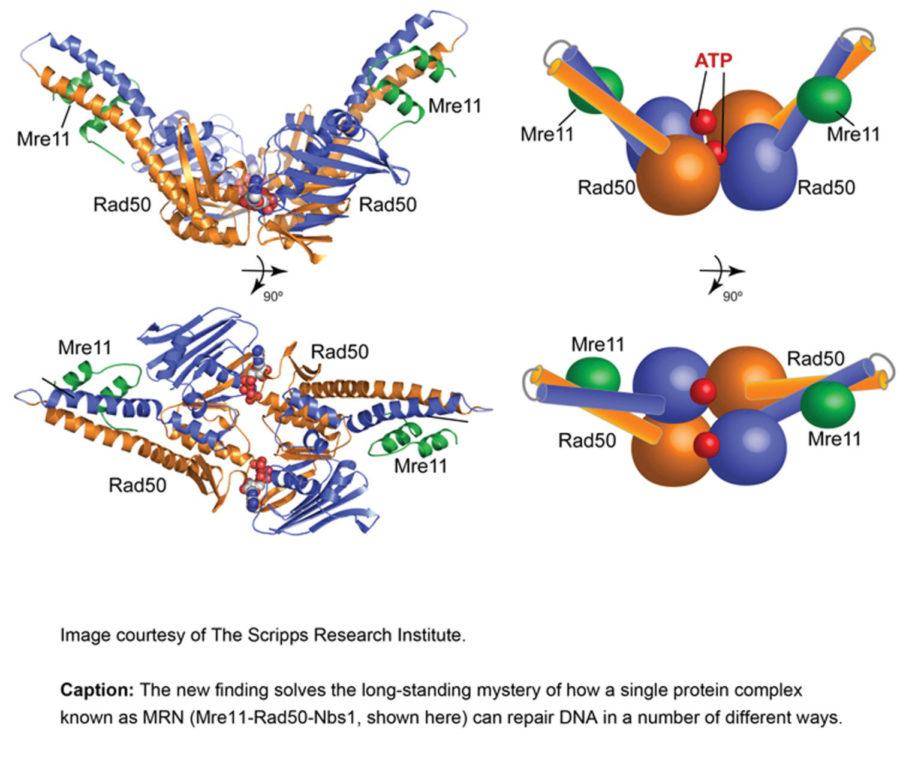Lauver: Genetically modified organisms feed the world
Photo courtesy of The Scripps Research Institute
The protein, named Mre11/Rad50, found in many organisms, such as viruses in addition to plants and animals, is used to repair DNA structure breaks. Scott Nelson heads the investigation to find the enzyme to repair DNA.
October 2, 2012
The term “genetically modified organism” can mean different things to different people. At the Iowa State vs. Iowa football game, I was told by an opposing fan: “You do know that bananas are made in factories, don’t you?” I calmly stated, “I’m sorry, but this banana was picked from a banana tree, most likely in Costa Rica.” I was then told: “No, that banana was made in a factory; it doesn’t have seeds, and is genetically modified.” After referencing trees and Costa Rica again, I realized I was not going to change this Hawkeye’s mind. I said farewell and received an “I just made you smarter, didn’t I, farmer?” for a goodbye.
So what is a genetically modified organism?
Such organisms are ones that have had their genetic material altered through genetic engineering. Some of the reasons crops, for example, have these traits inserted into them is to decrease pest pressure and limit the use of additional herbicides. Limiting the use of herbicides is crucial as we strive to promote a healthy environment for both humans and wildlife around the world.
Unfortunately, a large part of the population has the wrong perspective of these trait-carrying crops. The popular belief of organizations such as the Alliance for Natural Health is genetically modified organisms are not safe to consume. Those organizations claim one simply cannot test genetically modified organisms for safety to one’s health. We have groups such as Millions against Monsanto spending time and money to create a negative buzz around genetically modified organisms.
These special interest groups have a goal of reverting back to production practices of the early 1900s that simply won’t produce enough food or our growing population.
In contrast, it is encouraging to see groups such as the Iowa Farm Bureau and Iowa Corn Growers Association providing training for farmers on how to explain the benefits of genetically modified crops when asked questions by consumers. However, in California, there is a ballot initiative on Nov. 6 that mandates the labeling of all foods containing genetically modified organisms. If the initiative passes, all foods containing genetically modified organisms will display a label explaining this to the consumer.
By labeling the product as genetically modified, you will not see anything about nutrition, dietary requirements or safety of the product. This “genetically modified” labeling will simply confuse the consumer and will not educate them on the facts behind genetically modified organisms. It will increase a heightened concern when groups such as the World Health Organization have stated genetically modified foods have not had an effect on human health in the countries where they are consumed.
Unlike the early 1900s, when 40 percent of Americans lived on farms across the nation, the U.S. Department of Agriculture now says fewer than 2 percent of Americans live on farms. American farmers must be more productive, cognizant of land stewardship and create a safe reliable food supply for the consumer through the use of genetically modified organisms.
Our world is going to have to become more dependent on genetically modified crops because of the increasing population and yields these traits offer. According to the USDA, there is a good reason for concern about our ability to feed 9 billion people by the year 2050. In order for farmers to be able to produce enough food to feed the increase of 2 billion people during the next 38 years, we are going to have to utilize biotechnology.
We will be farming less fertile land due to land degradation. According to the National Resources Conservation Service, we have seen the productivity of several areas around the world decline by 50 percent due to soil loss. Many of these areas have malnourished people, especially developing countries in West Africa.
If we don’t take advantage of genetically modified crops and the increased yields they offer, we are going to be dealing with a lot more issues of hunger in the future. We have already been taught that when food prices go up due to less supply, developing countries can afford less food. It is morally unacceptable to let the starvation increase or even continue, for that matter. We must use these genetically modified organisms to our advantage to feed the hungry planet.
The root cause of the future issue we are facing is the supply and demand of the world’s cereal grains. It is senseless not to use the technology we have created with the resources provided around us. Envision buying a new tractor to increase efficiency but letting it sit in the shed and plowing with a horse instead. It does not make sense in our current world fueled by technology.
If we have safe ways to increase yields that will feed more people, why not use them?

















